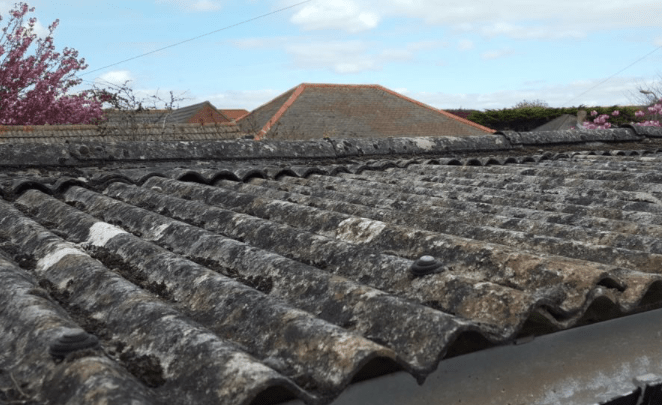If you are looking at your home or business premises and wondering how to recognise asbestos in any element of the roofing, here is a quick guide to the various sheets and components it can be found in.
- Corrugated – predominantly found on farms and industrial construction they were a better solution to corrugated metal which did not offer much insulation and would rust over time. Also commonly found on residential garages and sheds
- Flat sheet – super water resistant these were used under floors and in walls for businesses and homes. On a roof it is also used as undercloak to hold up the edge of the roof tiles on a gable.
- Lumber – soft enough to be worked like timber but fireproof, asbestos lumber was used as a base for roofs.
- Drainage pipes and guttering – made of asbestos cement for both durability and strength.

What are the main risks of asbestos roofing?
If asbestos roofs carry so much risk, then why was it used? Asbestos has great thermal qualities as well as fire retardancy. It also has high tensile strength, durability, and white asbestos is hydrophobic so repels water, which meant it was used in roofing and insulation products extensively in the 20th century. Asbestos has been dubbed the silent killer because it can be many decades after exposure that health issues emerge. As well as asbestosis, exposure to it can lead to mesothelioma, lung cancer and pleural thickening. It is this reputation which causes such concern when it is discovered as well as the knowledge that the owner can be responsible to any harm that incurs through contact. Roofs by their very nature are subject to the elements so the risk increases once the cement encasing the asbestos begins to degrade
What is the lifespan of asbestos roofing?
These types of roofs can last anywhere between 25 – 40 years, and are often left in situ for far longer than this. Given the regulation and legislation around these, any encountered now on site are likely at the end of their lifespan. Does this mean they should immediately be removed? Not necessarily. Whilst removal and disposal can be safely facilitated through us and our trusted licensed asbestos removal contractors, there are other options. Generally, the first course of action is to try to repair the roof. With roofing the risk from asbestos is low because it is encased in cement. Trying to remove it could in fact disturb the asbestos unnecessarily. The appropriate action to take would be established through our initial survey of the roof.
What’s the safest way to fix a leak in an asbestos roof?
In terms of repair it may be possible just to use products to fill cracks or cover the affected area with a sheet. Roofs over time are subject to UV, rain, and frost which can all weaken and degrade the surface. The issues arise when the surface becomes brittle and cracks appear. This has the potential to release the harmful fibres within the asbestos so that a section may need to be sealed or in cases where the roof really has reached the end of its life then it may be prudent to entirely remove and replace the sheets, or alternatively the old cement roof sheets are over clad with a new safe option
We offer a Complete Asbestos Testing Kit in our shop to allow you to safely sample some of the asbestos containing materials commonly found in buildings built or constructed prior to 2000.
For further information or advice about asbestos testing, removal or management please visit our contact page or visit us at www.artisanenvironmental.co.uk.

